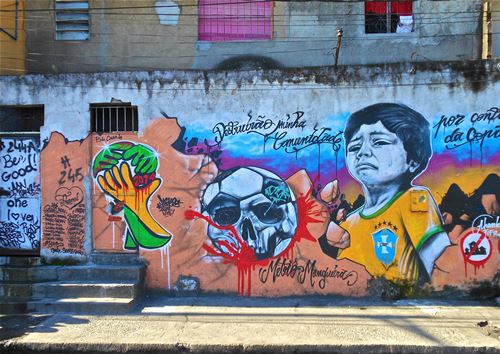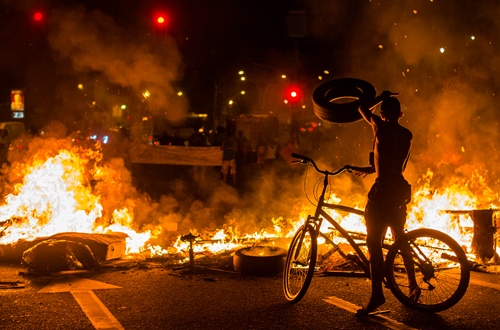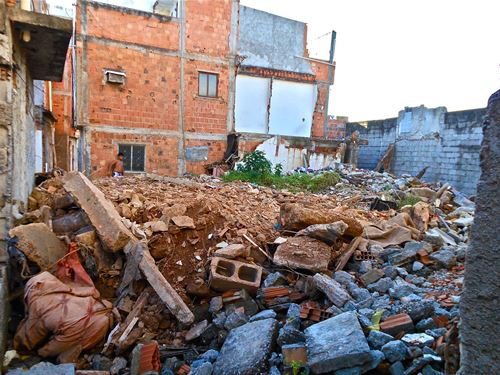Rio de Janeiro: a story of occupations and evictions
- June 17, 2014
City & Commons
The Homeless Worker Movement occupied a building in Rio, helping to shelter thousands — but in the run-up to the World Cup they were violently evicted.
- Author
It’s been five years since Brazil celebrated its selection by FIFA to host the ongoing 2014 World Cup. The announcement was made in great style on Copacabana Beach, packed with thousands jumping, dancing and in many cases partying all night — in what many would consider to be true Brazilian style. FIFA clearly thought that this was the safe choice in its gradual march around the globe, bringing recalcitrant nations and continents into its orbit. Brazil, after all, is the prototype football-crazy nation, where the whole country grinds to a halt to watch its squad in action. So who could possibly imagine that four years later millions of people would be marching through the streets not only of Rio and São Paulo but also Brasília, Belo Horizonte, Recife, Salvador, Goiania, shouting Não Vai ter Copa! (‘There won’t be a World Cup!).
The original impetus for the massive demonstrations of 2013 was a nationwide rise in bus fares, but with the upcoming Confederations Cup, FIFA’s dress rehearsal for the World Cup, public attention quickly focused on the vast sums being invested in stadiums and the infrastructure for the tournament. The “FIFA standard” of the new stadiums was contrasted with the recurrent problems of public transport, health and education. The double whammy of also being selected to host the 2016 Olympics engendered a wildly ambitious restructuring and development plan in Rio de Janeiro.
On December 5, 2009, the Strategic Plan of the City Government announced by Mayor Eduardo Paes presented as one of its core aims the reduction of the total surface area occupied by favelas (shanty towns) by 3.5%, purportedly because they were located “in areas at risk of landslides or flooding, conservation areas, or areas of public utility.” But as a banner carried by a protesting victim of this eviction policy read: “When rich people live in the South zone, it’s called a noble area, when poor people live there it’s called an area at risk.”

Graffiti on the walls of Metro Mangueira by the Moroccan-French artist Pleks Kustom (photo by author).
Even the beloved Maracana stadium, an international icon of Rio’s identity, had to be entirely reconstructed in line with FIFA directives. In the process the geral — the cheap standing area occupied by Rio’s most ardent football fans — has been abolished, effectively excluding the poorer part of the population from attending games. Watching live football is now the privilege of the “whites”, the upper and middle-class spectators who are able to pay more for the right to watch the game sitting down. In the process of reconstructing Maracana, the developers hit on a perfect scheme for earning more money by knocking down the surroundings as well to make space for a massive parking lot and shopping mall.
The destroyed surroundings of the stadium included Friedenreich School, one of Rio’s best municipal schools (in a country which ranks 78th for quality of education); Lanagro, Rio’s only laboratory for analyzing foodstuffs (while Brazil has the highest consumption of pesticides in the world and all corn and soy plantations are genetically modified); the Olympic-standard Celio de Barros athletics complex and Julio de Lamare water-sports complex (both newly reconstructed at vast expense for the 2007 Pan-American Games and used for training Rio’s Olympic athletes); Metro Mangueira, a poor community built 34 years ago by the construction workers of the Rio underground, hence its name; and finally Aldeia Maracanã, a multi-ethnic indigenous community created in 2006 around the abandoned 19th century building, which had long been associated with indigenous culture and which housed the Indian museum for over twenty years.
Metro Mangueira is emblematic of the many evictions carried out or planned in the lead-up to the World Cup and the Olympics. It was once an orderly, close-knit community and, although poor, the houses were solidly built by construction-workers. In October 2010, employees of the City Council started informing the inhabitants that their community was “at risk”, marking their houses with crosses and numbers, reminiscent of the Nazi practices in Jewish ghettos. The 107 families who accepted were moved to Cosmos, some 45 miles away, causing enormous hardship for those with jobs or schools nearby. The City Council tractors then moved in to demolish the newly abandoned homes, leaving huge holes and piles of broken masonry, opening the community to drug dealers, prostitution and a plague of rats and mosquitoes.
As a result, the official explanation used to justify the eviction became a self-fulfilling prophecy. With families and individuals occupying the ruins and rubble of the demolished homes, the area was soon transformed into a risk zone. Finally, at the beginning of 2014, with the World Cup in sight, the demolition trucks moved back into the community. Instead of a real option for those about to be evicted, the city council proposed to register them in the federal programme Minha Casa, Minha Vida (My House, My Life) which subsidizes low income families to acquire houses. Although federal, this program is administered by city councils in each state. There have been no new public housing developments in the central area of Rio, so the register is just a piece of paper. Popular resistance to the demolition of Metro Mangueira lasted several days and led to a large contingent of military police attacking young and old alike with pepper spray, bombs and rubber bullets.
Before the advent of Google Maps, maps of Rio de Janeiro depicted the older, more traditional areas of the city and the newer expansions towards Barra and Recreio while the rest of the area was apparently uninhabited space. Google maps dealt a serious blow to this bucolic image of the Cidade Maravilhosa (‘Wonderful City’) by revealing that all available space in the urban area — hills, valleys, rough ground — was occupied by favelas. The reaction of much of the elite was a sense of betrayal, but it’s impossible to sweep these satellite images under the carpet. Suddenly everyone was forced to admit the favelas‘ existence.
After the draconian austerity measures and structural reforms imposed by the IMF during the debt crisis of the 1980s, the favelas had spread rapidly as more and more people were driven to the cities by the expansion of industrial agriculture. In their new urban dwellings, the inhabitants lingered in a sort of limbo-state, as an auxiliary labor force at wages insufficient to adequately feed their families, let alone pay for housing. Signs of the acute housing crisis in Rio are reflected in the number of people — even entire families — sleeping in the streets in the city center, while new favelas continuously spring up in every available space.
So when at the beginning of April 2014 some of the leaders of the Movement of Homeless Workers identified a large building and surrounding yard and out-houses which used to belong to the former telephone company Telerj, and which had been abandoned for nearly twenty years, they quickly set about occupying the area. Thousands of families invested their minimal resources into buying planks to construct huts in the area which in the space of a week was occupied by ten thousand people. Although the occupants of the Telerj building included pregnant women, elderly people and thousands of children from babies to adolescents, no real attempt was made to identify the occupants or investigate their necessities.
TV Globo, Brazil’s biggest television network, was quick to denounce the “invaders” as criminals, flying over the area for aerial shots of the “invasion.” The telephone company that took over from Telerj — Oi — had never occupied the building, which was going to be sold to the city government and which was destined for the ‘My House, My Life’ program. However, with the impasse of the occupation, the “owners” soon appeared and a suit for reintegration of the property was rushed through the courts. On Wednesday, April 9, Mayor Eduardo Paes announced that the occupation had been carried out by organized professionals, implying criminal intent, and declared that the area should be “disoccupied” and returned to its owners. The mayor went as far as stating that “really poor people who need houses don’t stake out their plots with planks and construction materials.”
So what was the solution for all this “criminal activity”? At dawn on April 11, 1.600 heavily armed military police invaded the area. Sleeping women were kicked awake, huts were knocked down, everyone was sprayed with chemical spray — not from the usual hand-held canisters but from massive cylinders the size of fire extinguishers, which the police carried in backpacks. All members of the press, whether corporate or independent, were expelled from the area and even one of the Globo reporters was arrested by police on the spurious charge that he was “throwing stones.” Occupants allege that four infants succumbed to the chemical spray and rumors circulated that one of the reasons for keeping reporters out was to prevent them from witnessing the fatalities.
The sheer number of people involved, the fact that noone had time to create a real register of the occupants of the building, and the pandemonium that ensued makes it impossible to corroborate the facts. Nonetheless, the photographs and videos of independent reporters on the scene bear witness to the terror of the “disoccupation.” Testimonies of many of those involved reveal that these are people who have already been evicted from other areas in recent demolitions and evictions, while others are victims of the rising prices engendered by the militarization of the favelas.
The occupation and subsequent eviction of the Telerj building, just as the destruction of the Metro Mangueira community, is exemplary of the complete disregard for right to housing of Brazil’s poorest people. On the one hand, entire neighborhoods are demolished to make space for parking lots and shopping malls, and on the other many favelas have been occupied by militarized police forces (UPPs). This means that communities lacking any form of public services are basically placed under permanent curfew, which goes under the dubious title of “Public Security,” and any kind of protest is treated as a criminal uprising.
The contagious spirit of the mass protests that have been rocking Brazil over the past year has also found fertile soil in the favelas, where the death of every young person murdered by police is another rallying cry for popular resistance. As the current wave of anti-World Cup protests shows, the genie is out of the bottle — and it will take a lot more than violent evictions and police repression to silence the awakened and indignant multitude.
Luciano Cunha is a Brazilian author, cartoonist and graphic designer. His latest creation is the anti-hero O Doutrinador (‘The Indoctrinator’), who — dressed in black, sporting a Sepultura t-shirt, carrying a machine gun and with his face covered by a gas mask to avoid identification — has set out on a mission to rid the country of its corrupt politicians. In less than a year the comic has drawn a lot of attention from infuriated Brazilians who in some way feel connected to the anti-hero’s mission. The popularity of O Doutrinador has sky-rocketed in the past year, drawing attention not only from those who support Cunha’s work, but also from government figures who attempt to muzzle him via lawsuits, violating his freedom of expression and trying to kill his creative liberty. We at ROAR are therefore very excited to feature a series of unique drawings by Cunha to illustrate our Brazil coverage in the coming weeks. O Doutrinador can be found on Facebook, YouTube, and his personal website.
Source URL — https://roarmag.org/essays/brazil-world-cup-favela-evictions/



